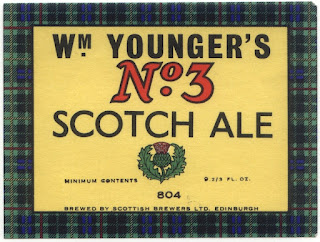No. 3 was by far the longest-lived, limping its way into the 21st century. What was the difference between No. 3 and 100/-? Not very much. The hopping rate is the same. And the only difference in the grist is the presence of a small amount of dextro-maltose. For which I’ve substituted No. 2 invert.
This was probably darkened with caramel. There’s nothing in the brewing record. But, it definitely was a little later. And there’s a No. 3 Pale, implying that this version must have been darker. A shade of 15 to 20 SRM would be my guess.
The presence of dextro-maltose, which would provide food for a slow secondary fermentation, implies to me that this was a Stock Ale. Probably aged for at least twelve months.
There were four types of hops: Kent, California, Württemberg, American, all from the 1883 harvest.
| 1884 William Younger No. 3 | ||
| pale malt | 15.75 lb | 92.65% |
| No. 2 invert | 1.25 lb | 7.35% |
| Cluster 150 min | 3.00 oz | |
| Hallertau 60 min | 2.00 oz | |
| Fuggles 30 min | 1.00 oz | |
| Goldings dry hops | 1.25 oz | |
| OG | 1077 | |
| FG | 1027 | |
| ABV | 6.61 | |
| Apparent attenuation | 64.94% | |
| IBU | 85 | |
| SRM | 9 | |
| Mash at | 153º F | |
| Sparge at | 163º F | |
| Boil time | 150 minutes | |
| pitching temp | 57º F | |
| Yeast | WLP028 Edinburgh Ale | |

No comments:
Post a Comment